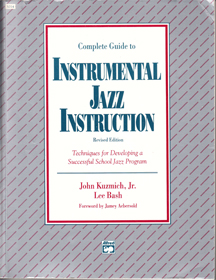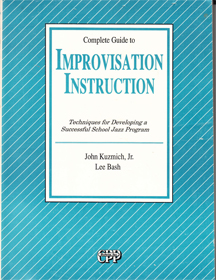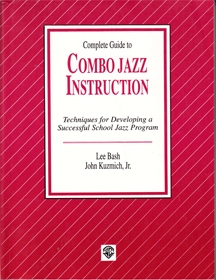John Kuzmich, Jr. Home Page
Step-By-Step Techniques and Practical
Guidelines:
-----------------------------------------------------------------------
Complete Guide to Instrumental Jazz Instruction:
Techniques for Developing a Sccessful School Jazz Program
by John Kuzmich, Jr. Ph.D. and Lee Bash



Note: all books are still available through Amazon with significant discounts at:
https://www.amazon.com/s/ref=nb_sb_noss?url=search-alias%3Daps&field-keywords=john+kuzmich&rh=i%3Aaps%2Ck%3Ajohn+kuzmich
Dear Music Educator:
This comprehensive set of books is designed to meet three specific
needs: a) College music education courses dealing with jazz
education; b) music teachers who have never taught jazz before but
want to make it part of their regular music curriculum; and c)
teachers who are looking for proven ways to turn out better jazz
players and ensembles. Here's a remarkable new guide that's tailored
to meet those needs comprehensively and thoroughly!
COMPLETE GUIDE TO INSTRUMENTAL JAZZ INSTRUCTION:
Book I Big Band Instruction
Book II Improvisation Instruction
Book III Combo Instruction
Written by two nationally-known music educators with a combined
experience of almost 60 years in virtually every segment of jazz
education, it's packed with practical daily help in
virtually every phase of jazz instruction and performance. For
example, you'll find:
Step-by-step techniques for organizing a jazz education
program.... from strategies for winning the approval of
administrators and designing curricula, to scheduling jazz in your
overall music program.
- Practical directions for setting up a large jazz ensemble,
including audition and selection of musicians, arranging optimal
seating and setups for rehearsals and concerts, establishing a
repertory, plus directories listing sources of basic jazz
literature and charts.
Specific information on how to establish and sustain a jazz combo
situation, including model programs, rehearsal techniques,
numerous sources for charts, performance strategies.
Down-to-earth advice on selecting jazz equipment, including
saxophones, trombones, trumpets, drums, cymbals, auxiliary
percussion equipment, bass amplifier, electric bass and piano,
guitars and guitar amps, sound modifiers, PA systems, and
recording equipment.
Rehearsal techniques for improving your ensemble's tone,
intonation, dynamics, breath support, blend, balance,
articulation, and rhythm development.
Extensive information about how to teach improvisation, with
multiple approaches, numerous sources of methods and materials,
and plenty of successful strategies that will enable even
inexperienced teachers to succeed.
Detailed blueprints for putting together a concert or festival,
from selecting the right music to deciding on the format and
length.
Suggestions for getting additional money for your jazz program,
including little-known funding sources and innovative fund-raising
ideas.
A multitude of ideas regarding extra-musical considerations such
as programming, promoting, and succeeding with festivals or
contests.
For quick access and easy use, all of this useful information is
organized into logical and distinct segments that, upon completion of
all three books, form a clear and comprehensive picture of virtually
every activity encountered in instrumental jazz instruction.
Back to top
Book I Big Band Instruction
I. JOINING AND CREATING THE JAZZ BANDWAGON Section I arms you with
hard-hitting tools to help you convince administrators and others of
the validity of jazz instruction as a fundamental part of the music
program...not a frill!
A. Why Join the Jazz Bandwagon? Includes a rationale
and checklist for any jazz curriculum
B. How to Organize the High School Jazz Program. Provides a
variety of models and scheduling options.
Demonstrates how to integrate philosophy with curriculum.
II. THE LARGE JAZZ ENSEMBLE: THE BACKBONE OF YOUR PROGRAM
A. How to Organize a Jazz Ensemble Program
- Identifies membership prerequisites.
Helps with audition and selection criteria.
Illustrates setups and rehearsal concepts.
Deals with incomplete instrumentation
Provides alternative scheduling formats.
B. Selecting Jazz Equipment
- Instrument selection.
Accessories.
- Auxiliary percussion.
Sound reinforcement.
C. Rehearsal techniques for the Jazz Ensemble
Planning/organizing.
Sight reading.
D. How to Successfully Put Together a Concert Chart selection.
Putting together the program.
Assessing the audience.
Pacing, concert format, and length.
Creating a lasting impression.
III. APPLIED JAZZ TECHNIQUES: DEVELOPING YOUR JAZZ SECTIONS
A. The Sax Section
- Jazz basics of saxophone playing.
Tone production and intonation.
Woodwind doubling.
B. The Brass Section Jazz basics of brass playing.
Tone production and intonation.
The role of the lead player.
Blending volumes and tone quality.
Special brass effects.
C. The Rhythm Section The role of the rhythm section.
Playing behind soloists.
The specific role of each instrument.
Getting the best sound from each instrument
Auxiliary percussion.
D. The String Section Various applications.
Amplification considerations.
Chart sources.
Jazz articulation techniques for strings.
IV. PUTTING IT TOGETHER
A. Budgeting and Funding: Survival of the Fittest
Finding the funding.
B. Promoting Your Program Through Special Activities Making use of
the media.
Hosting a jazz festival.
Concert touring.
C. Have I Been Successful? A Self-Evaluation Checklist
Back to top
Book II Improvisation Instruction
I. OBTAINING AN IMPROVISATION OVERVIEW
A. Towards a Comprehensive Approach to Improvisation
Historical overview.
Understanding the role of improvisation within music education.
Identifying the elements of jazz improvisation.
B. Standard Approaches to Teaching Improvisation Making use of
"chops," ears, and theory.
Making use of chords.
Three traditional approaches.
C. How to Use This Book Helpful guide to maximizing the use of
this book.
II. GAINING LISTENING SKILLS
A. The Importance of Listening: Developing and
Attaining Basic Skills Aural perception applications.
Historical-analytical applications.
Understanding solo construction.
B. Generating a Listening Focus Designed to Aid Improvisation
Style perspectives.
- Gearing the solo to the size of the ensemble.
Where's the groove?
Jazz-rock and Latin jazz.
C. Identifying Improvisation Strategies from Guided Listening
Activities How to analyze recorded solos.
Transcriptions
III. IMPROVISATION: THE PRIMARY TOOL IN JAZZ CREATIVITY
A. Teaching Improvisation to an Individual Student
Working at specific levels.
How to organize improvisation practice.
Chord/scale selection.
B. Teaching Improvisation in a Heterogeneous Classroom Basic group
improvisation techniques.
Three main approaches.
Using five minute warm-ups.
C. Teaching Improvisation in a Combo Setting Special
attributes.
Scheduling considerations.
Basic comping styles.
IV. USING MATERIALS TO ENHANCE INSTRUCTION
A. Guidelines for Using Published Improvisation
Methods. More than 20 of the most popular methods are reviewed and
critiqued.
B. Maximizing Improvisation Instruction via Published Materials.
Selection criteria.
Extensive bibliography and source listing.
Back to top
Book III Combo Instruction
A. Why the Jazz or Rock Combo? The role of the
combo.
Confronting the issues of the combo in the education setting.
Basic needs.
Creativity: the key ingredient provided in the combo.
B. Getting Started. Curricular guidelines.
Selecting students.
Scheduling considerations.
Model programs.
C. Materials for the Combo Basic literature.
Developing a repertory.
Chart sources.
D. Applied Techniques for the Jazz or Rock Combo The role of the
director.
The rhythm section.
Melodic instruments.
Combo rehearsal techniques.
The importance of listening during rehearsal.
Self-generated MIDI accompaniments.
E. Selecting Jazz Equipment Drum kits.
Amplifiers.
Digital keyboards.
Sound systems.
F. Teaching Improvisation in the Combo Setting Rehearsal
guidelines.
Comping considerations.
G. How to Successfully Put Together a Performance. Selecting
effective charts.
Promoting your program.
Jazz festivals and contests.
In short, the GUIDE gives you practical techniques for building
all aspects of a successful school jazz program. It will be an
indispensable reference for the experienced jazz educator and an
ever-ready assistant for the instrumental teacher who is seeking to
make jazz an integral part of a complete music education.
Each book is $22.95 and together there are over 600 pages of text
in three books. There will also be a special three-book set being
made available at a discounted price.


